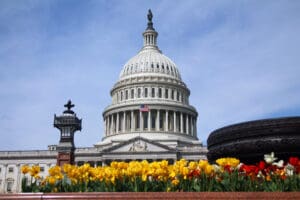Transcript
Tax policy is almost always a balancing act between the tax rate - how much someone pays - and the tax base - who or what is being taxed.
When the balance is right, the government is able to generate revenue and there are positive economic outcomes.
When the balance is off, revenue can be unstable, and individuals, businesses, and the economy suffer.
Generally, the right balance is a low rate paired with a wide base.
This was the recipe for success in the 2017 Tax Cuts and Jobs Act (TCJA).
The TCJA lowered the corporate tax rate from 35 to 21%, but it also greatly expanded the corporate tax base through a number of domestic and international provisions.
Together, the lower rate combined with a wider base allowed companies of all sizes to grow, create more jobs, and innovate more effectively.
Parts of the TCJA are set to expire in 2025.
Other provisions are permanent, like the reduced corporate income tax rate and the expanded base.
Despite this, there are growing calls to raise the corporate tax rate again.
But because the corporate tax base is so much broader now, raising the rate will increase the overall burden more in 2025 than it would have before the TCJA, potentially resulting in a higher corporate tax burden than pre-TCJA.
Even the smallest increase could do major harm to economic growth, wages, job creation, and innovation.
To paint the full picture, and achieve sound tax policy, we have to consider the rate AND the base.
Related Articles
Stay informed on the tax policies impacting you.
Subscribe to get insights from our trusted experts delivered straight to your inbox.
SubscribeFeatured Resources

A Tax Reform Plan for Growth and Opportunity: Details & Analysis
This tax reform plan would boost long-run GDP by 2.5%, grow wages by 1.4%, and add 1.3M jobs, all while collecting a similar amount of tax revenue as the current code and reducing the long-run debt burden.
38 min read
Tax Calculator: How the TCJA’s Expiration Will Affect You
Unless Congress acts, Americans are in for a tax hike in 2026.
3 min read
Considering Tax Reform Options for 2025 (and Beyond)
Given that U.S. debt is roughly the size of our annual economic output, policymakers will face many tough fiscal choices in the coming years. The good news is there are policies that both support a larger economy and avoid adding to the debt.
6 min read
Options for Navigating the 2025 Tax Cuts and Jobs Act Expirations
Policymakers should have two priorities in the upcoming economic policy debates: a larger economy and fiscal responsibility. Principled, pro-growth tax policy can help accomplish both.
21 min read
Expiring TCJA Tax Provisions in 2026 Would Produce Substantial Tax Hike across the US
At the end of 2025, the individual tax provisions in the Tax Cuts and Jobs Act (TCJA) expire all at once. Without congressional action, most taxpayers will see a notable tax increase relative to current policy in 2026.
4 min read
Conference on Tax Cuts and Jobs Act’s Effects Shows Further Tax Reforms Needed in 2025
Lawmakers should see 2025 as an opportunity to consider more fundamental tax reforms. While the TCJA addressed some of the deficiencies of the tax code, it by no means addressed them all.
8 min read